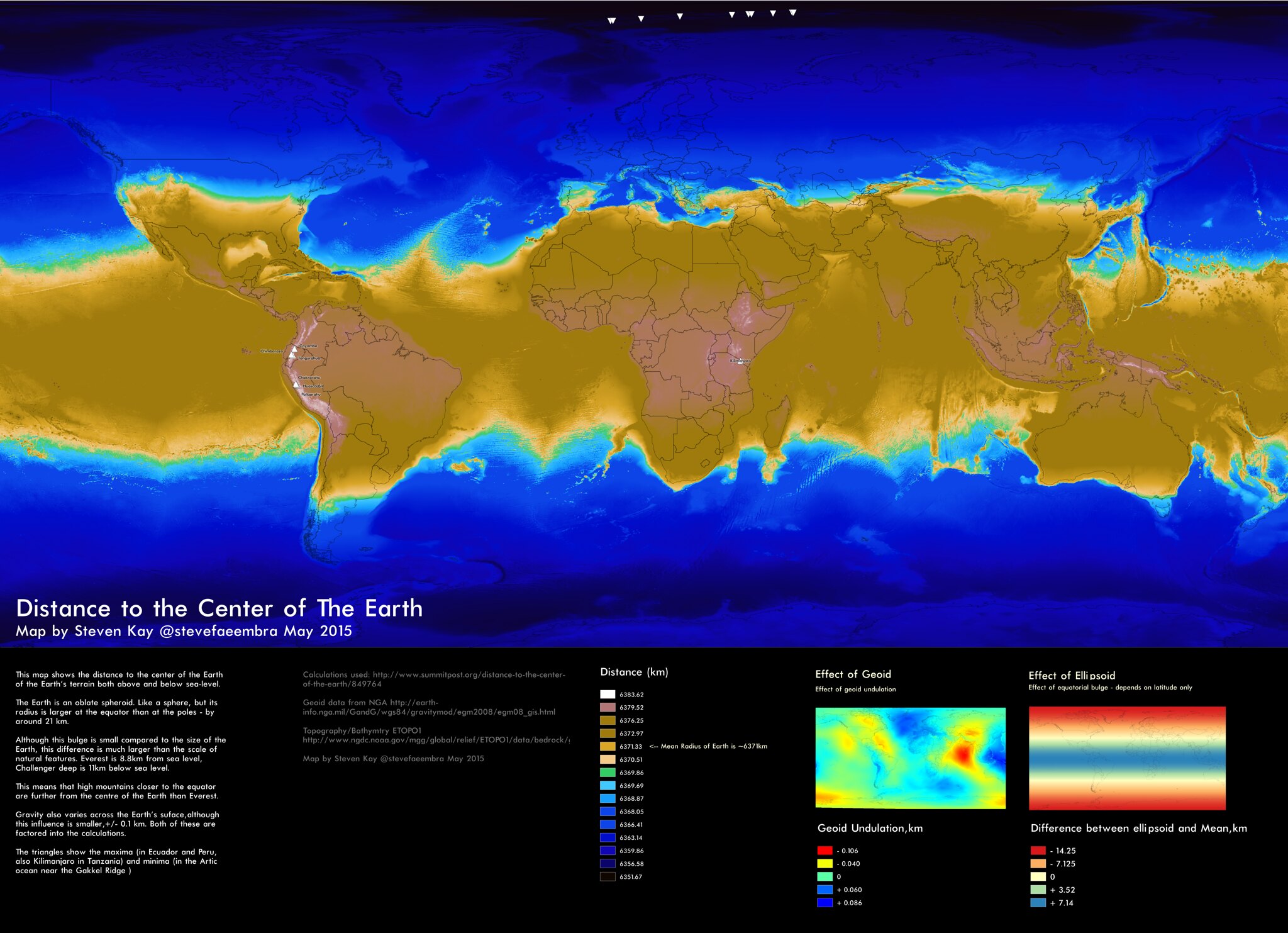"Potato Earth" Gravity Map
We asked yesterday if the pull of
gravity is the same everywhere on Earth. As many of you noted, the
answer is no.
This map of Earth's gravity field, based on airborne and
satellite measurements, depicts variations in Earth's gravity field.
As
Astronomy Picture of the Day explained when they ran a similar image in
2014: "High areas on this map, colored red, indicate areas where gravity
is slightly stronger than usual, while in blue areas gravity is slightly
weaker.
Many bumps and valleys can be attributed to surface features,
such as the North Mid-Atlantic Ridge and the Himalayan Mountains, but
others cannot, and so might relate to unusually high or low sub-surface
densities."
In addition, processes happening deep in the Earth's
mantle—such as descending tectonic plates and hot mantle plumes—can also
affect the strength of the gravitational field.
From GisGeography
Dig a Canal Away From the Ocean
The geoid is a measurement of mean sea level (MSL).
When you average out the motion of waves, the level at which water settles is MSL.
To calculate MSL, all you have to do is just measure the average level of the oceans… and there you have it.
But how about on land?
Let’s say you dig a canal away from the ocean inwards to the land.
The level the water would settle could be interpreted as mean sea level.
The geoid is the hypothetical MSL without digging a canal…
And it’s used by surveyors to measure precise surface elevations as a true zero surface in a vertical datum.
Distance to the center of the Earth
Defy Your Notion of Gravity with the Geoid
All objects on Earth fall at 9.81 m/s2 (meters, per second, per second).
Actually, no they don’t.
Gravity differs where you are on Earth, as shown in the geoid model.
For example, mountains have more mass than valleys.
As a result, gravity at the Rocky Mountains is relatively stronger to other locations on Earth.
Gravity on the Earth’s surface ranges from 9.7639 m/s2 in Peru to 9.8337 m/s2 in the Arctic.
This also means that our planet is actually very bumpy and non-uniform.
It’s not a sphere.
It’s not as smooth that most people tend to think it is.
Data courtesy of NASA’s GRACE Gravity Model
Other effects on gravity are because:
- The Earth bulges at the equator from rotational forces. This means the difference from the center of the Earth and the surface is smaller at the poles than at the equator.
- The material composition of the Earth varies and matter isn’t evenly distributed, which adds more complexity to understanding gravity.
How do you measure the geoid?
To measure mean sea level, you can use a tide gauge and average out the results over a long period of time:
Tidal Gauge | Image Credit: NOAA
But you’d need a lot of tide gauges placed around the entire globe.
So this is why satellites like NASA’s GRACE mission (Gravity Recovery and Climate Experiment) and ESA’s GOCE mission (Gravity Field and Steady-State Ocean Circulation Explorer) are measuring our planet’s gravity field with a precision never obtained before.
How do these satellite missions do this?
GRACE is a pair of satellites in the same orbit approximately 220 kilometers apart.
When the leading satellite increases speed, this means there is a greater gravitational pull. If the leading satellite slows down, this means there is less gravitational pull.
These tugs and pushes in gravity are measured using microwave pulses from one satellite to the other. Each satellite position is being pinned down with GPS.
The end result is the most accurate measurements of gravity anomaly to date.
Keeping Your Feet on the Ground with Geoid Applications
Geoid applications include weather forecasting, drought predictions, survey accuracy, water cycle, polar ice mass loss and anything that can track mass change.
Here are some detailed geoid applications:
Predicting Earthquakes from Subduction Events
Earth’s Interior – Scientists are closer than ever to earthquake prediction.Because we can retrieve variations in the geoid, these subduction events are like retrieving earthquake signatures.
Geoid variations were associated with more than 98 per cent of the earthquakes of magnitude 9 or above, around 60 per cent for magnitude 8.8, 40 per cent for magnitude 8.6 and 33 per cent for magnitude 8.3.
Understanding Ocean Circulation and Sea Level Change
Climate Change – Ocean circulation, tide gauges and sea level…If all the ice melted, climate scientists would measure change by the Earth’s rising sea levels and tide gauges.
GRACE measures mass change from the melt of Arctic ice.
It helps us understand if ocean circulation is changing and how if affects world climate change.
Wrapping Things Up
As you walk around Earth, you weigh a little more or less depending on where you are.
It’s actually a function of how much mass is below you.
The geoid derived from the GRACE and GOCE missions can sense just how much that mass is.
We love remote sensing applications.
And the list goes on for these uniquely interesting satellite missions.
Earthquake prediction, climate change models and the water cycle are some of the areas that the geoid is helping us understand how our Earth works.
But the list of GRACE applications doesn’t stop here.
Links :
- See more versions of "Potato Earth" from the Helmholtz Centre at : http://www.gfz-potsdam.de/en/media-communication/image-galleries/geoid-the-potsdam-gravity-potato/
- Scientific American : The geoid why a map of earths gravity yields a potato shaped planet
- NASA : about gravity anomaly maps
- TechInsider : Map gravity earth space
- GeoGarage blog : Goce gravity map traces ocean circulation / Explainer: how do you measure a sea's level, anyway? / Goce gravity mission traces ocean circulation / Earth's gravitational field mapped by researchers



No comments:
Post a Comment